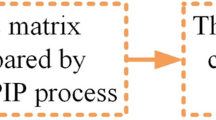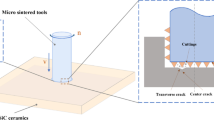Abstract
Wave-transmitting Si3N4 ceramics exhibits high levels of brittleness, and the milling surface inevitably exists defects. Critical cutting depth is an important reference parameter to improve the surface quality and processing efficiency in milling. A theoretical mathematical model has been proposed to predict the critical cutting depth in the study. The contact relationship between the tool cutting edge and the ceramics surface is analyzed, and the non-uniform bearing crack system is established. The micro cracks propagation critical condition has been put as the criterion of critical cutting depth. Through the model calculation, the critical cutting depth is 0.38 mm, and it is confirmed the critical cutting depth is between 0.3 and 0.4 mm with experimental results. The model predictions are consistent well with the experimental results. In addition, the theoretical model shows that the critical cutting depth decreases exponentially with the increase of the material hardness, while the increase of fracture toughness, tool helix angle and side edge rear angle, leads to critical cutting depth rising. The theoretical model can be applied to evaluate the critical cutting depth of brittle ceramics in milling.
Similar content being viewed by others
References
Chen M, Yin XW, Li M, Chen LQ (2015) Electromagnetic interference shielding properties of silicon nitride ceramics reinforced by in situ grown carbon nanotubes. Ceram Int 41(2):2467–2475
Han ZL, Li CH, Wang S, Mao WP (2013) Experimental investigation into material removal mechanism of Nano-ZrO2 dental ceramic grinding. China Mech Eng 24(09):1150–1154
Fang FZ, Zhang GX (2004) An experimental study of optical glass machining. Int J Adv Manuf Technol 23(3–4):55–160
Lv DW, Hong X, Tang YJ, Huang YH, Li ZP (2013) Influences of vibration on surface formation in rotary ultrasonic machining of glass BK7. Precis Eng 37(4):839–848
Lv DW, Huang YH, Wang H (2013) Improvement effects of vibration on cutting force in rotary ultrasonic machining of BK7 glass. J Mater Process Technol 213(9):1548–1557
Nath C, Lim GC, Zheng HY (2011) Influence of the material removal mechanisms on hole integrity in ultrasonic machining of structural ceramics. Ultrasonics 52(5):605–613
Qin N, Pei ZJ, Treadwell C, Guo DM (2009) Physics-based predictive cutting force model in ultrasonic-vibration-assisted grinding for titanium drilling. J Manuf Sci Eng Trans ASME 131(4):0410111–0410119
Ya G, Qin WH, Yang SC, Xu YW (2002) Analysis of the rotary ultrasonic machining mechanism. J Mater Process Technol 129(1–3):182–185
Rusnaldy TJK, Kim HS (2007) Micro-end-milling of single-crystal silicon. Int J Mach Tools Manuf 47(14):2111–2119
Liu K, Li X, Liang S (2007) The mechanism of ductile chip formation in cutting of brittle materials. Int J Adv Manuf Technol 33(9):875–884
Wang CY, Zhou L, Fu H, Hu ZL (2007) High speed milling of graphite electrode with endmill of small diameter. Chin J Mech Eng 20(4):27–31P
Wu H, Zuo DW, Sun QP, Sun YL (2015) Research on ductile regime milling of fully sintered dental zirconia. Trans Beijing Inst Technol 35(9):902–907
Bian R, He N, Ding WZ, Liu SQ (2017) A study on the tool wear of PCD micro end mills in ductile milling of ZrO2 ceramics. Int J Adv Manuf Technol 2017:1–10
Funding information
The authors would like to thank China Postdoctoral Science Foundation funded project under No. 2015M581462.
Author information
Authors and Affiliations
Corresponding author
Rights and permissions
About this article
Cite this article
Liu, Y., Liu, X., Wei, S. et al. Investigation on critical cutting depth in milling of wave-transmitting Si3N4 ceramics. Int J Adv Manuf Technol 94, 4065–4071 (2018). https://doi.org/10.1007/s00170-017-1114-3
Received:
Accepted:
Published:
Issue Date:
DOI: https://doi.org/10.1007/s00170-017-1114-3




